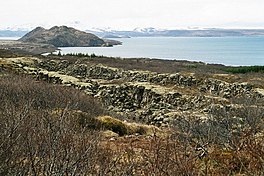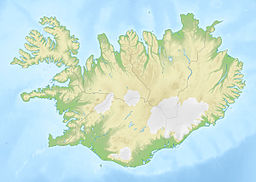Þingvallavatn (Icelandic pronunciation: [ˈθiŋkˌvatlaˌvahtn̥] ), anglicised as Thingvallavatn, is a rift valley lake in southwestern Iceland. With a surface of 84 km2 it is the largest natural lake in Iceland. Its greatest depth is 114 m. At the northern shore of the lake, at Þingvellir (after which the lake is named), the Alþingi, the national parliament, was founded in the year 930, and held its sessions there until 1799 and still as of today the name Alþingi Íslendinga is carried by the parliament of Iceland.
| Þingvallavatn | |
|---|---|
 Fissures at the lake | |
| Location | Þingvellir National Park |
| Coordinates | 64°11′15″N 21°08′06″W / 64.18750°N 21.13500°W |
| Primary outflows | Sog |
| Basin countries | Iceland |
| Surface area | 84 km2 (32 sq mi)[1] |
| Average depth | 34 m (112 ft)[1] |
| Max. depth | 114 m (374 ft)[1] |
| Water volume | 2.856 km3 (0.685 cu mi)[1] |
| Residence time | 11 months[2] |
| Islands | Sandey |
The lake lies partially within Þingvellir National Park. The volcanic origin of the islands in the lake is clearly visible. The cracks and faults around it, of which the Almannagjá [ˈalˌmanːaˌcauː] ravine is the largest, is where the Eurasian and North American tectonic plates meet. Silfra fissure is a popular scuba and snorkeling site. The only outflow from lake Þingvallavatn is the river Sog.
One of the noted features of the lake is the presence of four morphs of the Arctic charr.[3]
See also
editNotes and references
editReferences
edit- ^ a b c d EÖÞ. "Vísindavefurinn: Hvað er Þingvallavatn djúpt?". Visindavefur.hi.is. Archived from the original on 2012-11-09. Retrieved 2016-04-23.
- ^ "Fróðleiksmoli: dvalartími vatns | Fróðleiksmolar | Veðurstofa Íslands" (in Icelandic). Vedur.is. Archived from the original on 2016-05-07. Retrieved 2016-04-23.
- ^ Malmquist, H. J., Snorrason, S. S., Skulason, S., Jonsson, B., Sandlund, O. T., & Jonasson, P. M. (1992). Diet differentiation in polymorphic Arctic charr in Thingvallavatn, Iceland. Journal of Animal Ecology, 21–35.
